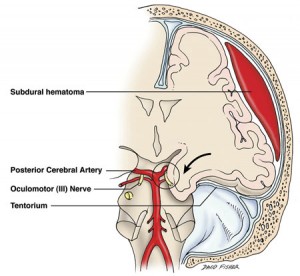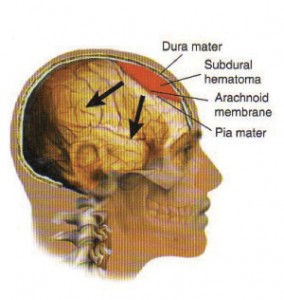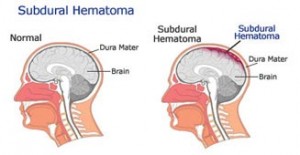Do you have a dear one who is suffering from headaches? Is he or she also walking with a wobbly gait and talking with a slurred speech? Get immediate medical treatment for the person for he or she may be having a condition called Subdural Hematoma.
What is Subdural Hematoma?
Page Contents

Picture 1 – Subdural Hematoma
Source – aao
What is a Subdural Hematoma? People without a medical background may be unaware of this syndrome. This is a condition that is marked by blood clotting or the formation of a collection of blood on the brain surface.
Subdural Hematomas are classified into two types. These are :
Chronic Subdural Hematoma
When Subdural Hematomas are found to arise due to an old injury, the condition is known as a chronic kind of Subdural Hematoma.
Acute Subdural Hematoma
Subdural Hematoma is a deadly syndrome that usually occurs after a head injury or trauma to the head surface. When the complication arises due to a severe head injury, it is called an acute case of Subdural Hematoma.
Subdural Hematoma is also known as “Subdural Hematoma hemorrhage” or “Subdural Hemorrhage”.
Where is a Subdural Hematoma found?
The Subdural Hematoma location is beneath the Dura or outer membrane covering the brain and the surface of the brain. In Subdural Hematoma blood pressure due to accumulation of blood inside the brain can cause severe damage.
Subdural Hematoma Mortality Rate
Subdural Hematoma, especially the acute variety, is the most lethal kind of head trauma. It causes death in as many as half of the sufferers. Subdural Hematomas appear in 15% of all head injury cases.
Subdural Hematoma Symptoms
Cases of Subdural Hematoma can give rise to a number of symptoms in patients. Some of the most prominent Subdural Hematoma signs and symptoms include
Headaches
In both types of Subdural Hematoma headaches are common. However, the nature of headache varies depending on the kind of the disorder patients are suffering from. While the headache is severe in acute cases of Subdural Hematoma, it is quiet intense and persistent in chronic Subdural Hematoma patients.
Increasing Intracranial Pressure
The patient normally experiences rising pressure within the skull in case of acute subdural hematoma. This is caused by a hematoma that is getting bigger in size within the brain. It is one of the Subdural Hematoma vital signs.
Paralysis
Both types of subdural hematoma can result in paralysis in the patients. This is the reason why the condition needs to be treated at the earliest.
Vomiting
Nausea and vomiting are common in patient with acute conditions of subdural hematoma.
Seizures
Acute cases of Subdural Hematoma can also lead to seizures in patients with head injuries.
Drowsiness
People suffering from a chronic kind of the condition can also experience sleepiness. This happens even after the person has proper sleep and rest.
Confusion
Chronic cases of Subdural Hematoma can also lead to confusion in patients.
Muscle Weakness
Chronic kind of the disease can also give rise to muscular weakness, which is often felt in only one side of the body.
Subdural Hematoma Causes
A number of reasons may give rise to Subdural Hematoma of the brain. These include :
Head Injury
As aforementioned, Subdural Hematoma arises due to head injury. Trauma to the head surface is the major cause of Hematoma below the Dura matter. In some cases, concussion happens due to brain injury and there is even loss of consciousness. If a person suffers faints after receiving a head injury, immediate medical treatment should be administered to him or her.
Brain Injury
Injury to the brain can also cause Traumatic Brain Injury (TBI). This damage may be restricted to only one area of the brain or may spread to other areas of the brain as well.
Sturge-Weber Syndrome
This rare genetic disease leads to abnormal growth of blood cells and calcium accumulation within the brain. This congenital disorder is often seen as a reason behind the appearance of Subdural Hematoma.
Menkes Disease
This inborn metabolic defect noticeably reduces the ability of cells to absorb copper. The copper deficiency is often supposed to give rise to Subdural Hematoma.
Alcohol Abuse
Long term alcohol use can lead to the appearance of this condition.
Age
Old age can often cause clotting of blood in the brain. However, in Subdural Hematoma elderly people are not the only one to suffer.
Subdural Hematoma Diagnosis
If a person shows some or all of the abovementioned symptoms, an immediate diagnosis of the condition is necessary. A physician diagnoses the disease with a MRI scan or CT scan. Repeated CT scans are also needed to find out if the hematoma is increasing in size. Other brain examinations such as X-Rays are also needed to examine the condition of the brain and to check if there has been any other head injury. Subdural Hematoma brain scan is also done with Electroencephalogram (EEG).
Blood tests are also good at detecting clotting or any other blood abnormalities in the brain.
Subdural Hematoma Treatment
The treatment usually depends on the type of Subdural Hematoma. A proper diagnosis of the condition is carried out to check whether it is of a chronic or acute variety. Thereafter, the physician begins the treatment.
A small Subdural Hematoma of the acute variety is usually treated with careful observation and monitoring. It does not produce any symptom. In such cases, the blood clot clears on its own after a period of time. However, in advanced cases of Subdural Hematoma symptoms start to show up and the condition of the person starts to deteriorate. The hematoma may continue to grow leading to increased pressure in the skull. In such cases of Subdural Hematoma surgery is highly recommended.
The Subdural Hematoma surgery involves either craniotomy or making “burr holes” in the skull. In Craniotomy, a part of the skull is removed and again put back in place after the coagulated blood has been removed. The clotted may also be sucked out by the “burr holes” method. This involves drilling small holes through the skull and “sucking” the blood out. Subdural Hematoma drainage is very important for a complete recovery.
Subdural Hematoma Recovery Time
Subdural Hematoma recovery is possible. However, a “complete” treatment usually depends on the time at which the disease has been detected. Early treatment of the syndrome can help in a better recovery. The size of the hematoma also plays a factor in the recovery. Small-sized chronic Subdural Hematomas, lesser than 1 cm in width, can be treated much better than acute Subdural Hematomas. Only 22% of Chronic Subdural Hematoma patients show a less positive outcome.
Simple Subdural Hematoma cases cause death in 20% patients. Complicated cases of Subdural Hematoma are a reason for death in about 50% people. Subdural Hematoma death is not too uncommon after a massive head trauma.
Subdural Hematoma Pictures
If you have no idea as to how the condition looks like, you may check these pictures of Subdural Hematoma. These Subdural Hematoma images will let you understand the appearance of this disorder.

Picture 2 – Subdural Hematoma Photo
Source – emsworld

Picture 3 – Subdural Hematoma Image
Source – vbsc
If you leave Subdural Hematoma untreated, it can lead to Subdural Hematoma complications. In severe cases, it may even cause death. So if you or any of your dear ones has suffered a head injury, it is best that you seek immediate medical assistance. Timely medical help can` increase the chances of complete recovery from the disease.
References:
http://en.wikipedia.org/wiki/Subdural_hematoma
http://www.nlm.nih.gov/medlineplus/ency/article/000713.htm
http://emedicine.medscape.com/article/828005-overview
http://nyp.org/health/subdural-hematoma.html
http://www.patient.co.uk/health/Subdural-Haematoma.htm
http://www.healthcentral.com/ency/408/000713.html
http://www.brain-surgery.com/subdural.html
http://www.wrongdiagnosis.com/c/concussion/intro.htm

Hello I would like to use an image you have for subdural hematomas in my book for the USMLE exam. Its a study guild book to help students. I would like to use the imagine in my book. I cannot down load it on this email but would be happy to email it to you…Can you email me so I can display the image I am interested in
Greg Fernandez M.D.
Sorry for late reply.
You may reuse pics but don’t forget to add credit for our website.
Thanks